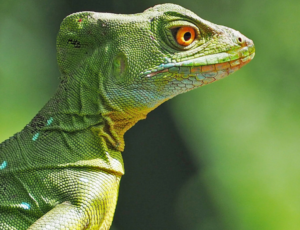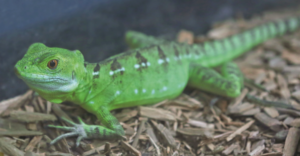TAXONOMIC INFORMATION
Kingdom: Animalia
Phylum: Chordata
Subphylum: Vertebrata
Class: Sauropsida
Order: Squamata
Suborder: Sauria or Iguania
Family: Corytophanidae
Genus: Basiliscus
Species: B. plumifrons
Binomial name: Basiliscus plumifrons (Cope, 1875)

Search the Internet for the “Jesus Christ lizard,” and you’ll be amazed by videos of this little lizard running across water— hence its moniker.* Most often, this is a flight response; National Geographic notes, “When threatened, they can drop from a tree into the water and sprint, upright, about 5 feet (1.5 meters) per second across the surface.”
How is this even possible? Observe the toes on their rear feet: when spread, there are “fans” of skin that unfold and increase the surface area of the “foot,” allowing them to create tiny pockets of air that will prevent sinking so long as the lizard keeps moving at the same speed—and they can keep this up for about 15 feet, enough to escape predators which cannot follow them on the water. For balance, they hold their tails high in the air.
The Jesus Christ lizard is an excellent swimmer, and so when running on water fails them, they can still swim away, or even remain underwater for up to 30 minutes. It’s the younger ones that do this more often.
“AT A GLANCE”
Other names
“Plumed” or “double-crested basilisk”
Natural habitat
Tropical rainforests of Central America, particularly southern Mexico and Panama; it is arboreal (prefers trees) and will never be found far from water
Diet
Omnivorous, but in captivity they become carnivorous, devouring insects smaller than them such as crickets, locusts, roaches, worms (including silkworms and waxworms), and even pinky mice
Lifespan
Estimated to be up to 10 years
Distinctive features
Males have high crests on their heads and backs, used to attract females
Appearance
Ranges from pale to bright green (with the occasional pale brown); underside tends to be yellow
Reproduction
They can reproduce when they are two years old; females lay eggs (up to 20 per breeding); hatchlings can already run, climb, and swim
Predators
Snakes, birds
Behavior
Territorial; best to give one its own enclosure. Experts advise you acquire one bred in captivity by a responsible and legal breeder as wild-caught ones are too nervous and skittish to handle, and may die of stress
Enclosure
• Never let their enclosures get too dry; make sure to mist it regularly, but provide good ventilation against the growth of mold
• Replace their water daily
• Provide a cool and a warm hide
Interview with the Breeder and Keeper
Animal Scene’s friendly expert Lendl Lin, who has generously shared his extensive experience with lizards with us in the past, answered several questions we had about the Jesus Christ lizard.
Q:What do you call the Basiliscus plumifrons in the local trade—the Jesus Christ lizard or the plumed or double-crested basilisk?
Lendl Lin (LL): We call it the Plumed Basilisk. Although for the non-hobbyists, “Jesus Christ lizard” is the more popular name.
Q: How popular is Basiliscus plumifrons among local keepers? Is it easy to get one locally?
LL: It is not that popular yet. Basilisks are quite skittish animals and people will sometimes try to get one, but fail to provide them big enclosures. And also, the availability here in our country is quite rare. It is easy to get one as long as you get it from the reptile importers/ sellers who sell them with legal documents.
Q: How big can you expect it to grow, how long is its lifespan, and what other basics should those interested in it know?
LL: In my experience, basilisks don’t really want bright light. It is very ideal to provide them with a source of UVB light like Zoo Med Reptisun 5.0 and a 40 watt daylight bulb for its UVA/heating requirements.
Basilisks’ eyes are very sensitive and if exposed to too much sunlight, UV, or light, their eyes get affected and to protect these, the basilisk just usually keeps them closed—at least in my experience with them. After I noticed this behavior, I added more plants, mopani wood, and places to hide. I also used Vitamin A reptile eye drops for them. So far, I haven’t seen their eyes irritated anymore.
Their lifespan is around 20 years in captivity. Its average size is 1 meter from snout to tail.

Q: They are known for having very agile and prehensile toes; what other unique characteristics does it possess? How hardy is it, or is it a delicate creature?
LL: The eyes are delicate, in my experience. For me, any reptile is delicate and won’t survive if the keeper does not do the proper research, prepare the needed budget, and practice good husbandry.
What makes it unique? Aside from running on water and jumping from high levels, it is very alert and can spot prey insects in an instant. And personally, I love their “sails.” It makes them very unique.
Q: How well known is its ability to “run” on water? The joke is that once you see this, it’s an unforgettable sight because it means your Basiliscus plumifrons is escaping from you! Can you comment on this?
LL: In captivity, they will rarely do this not unless you have a very, very, very huge enclosure with a river-like system in it (laughs).
Q: What attracted you to Basiliscus plumifrons, and made you want to keep them?
LL: I personally love lizards and any lizard for me is beautiful. But what I loved about them is their personality. You go inside the room and you can see them observing you. And of course, there’s their prehistoric look.
Q: Was it difficult for you to raise Basiliscus plumifrons? Can you share with us some of your experiences/ difficulties in keeping them?
LL: Well, just like other lizards, they need big enclosures. They get scared easily and if the enclosure is too bare, they will run and injure themselves by hitting the enclosure walls. Their eyes are sensitive to strong light as well. They need a lot of bushy plants and a big water source.
Q: What are the best things you’ve learned about keeping it—advice you can share with other keepers?
LL: They are very intelligent and beautiful animals. Do your research and provide the things that they need: proper UVBs, basking/heat bulbs, bigger enclosures, correct substrate, and a large pool of water. Also, do not forget to put lush/ thick vegetation or plants. They love it!
Q: What do you feed them, and how often? Is obesity a potential problem for Basiliscus plumifrons?
LL: Yes, obesity is a potential problem especially when you just feed them mainly worms. I feed mine with superworms, crickets, dubias, and occasionally, fruits. Also, I always dust their food with Zoo Med’s Repticalcium with D3
Q: How do you know when Basiliscus plumifrons is healthy, and when it is not? Are there any conditions or health problems it’s been prone to in your experience?
LL: If they are sleeping all the time and timid, there could be a problem; this is also true if they keep their mouths open all the time and don’t eat regularly. Most basilisk problems I’ve known and experienced are eye problems.
Q: Who, in your opinion, would make a good keeper for Basiliscus plumifrons? How much prior experience should they have?
LL: For me, anyone can keep it as long as they did their research and are Animal ready to commit their time, budget, and effort to keep the animal happy. But I say it would be better if keepers had immediate to expert levels of experience with reptiles take care of them.
Q: Is Basiliscus plumifrons a “look but don’t touch” type of pet? How closely can a keeper handle one?
LL: Yes, “look but don’t touch” since they are very nervous and skittish. To avoid stressing them out, it’s better to leave them alone in the enclosure and admire their beauty.
(Editing and Additional Text/Research by CFB)
Sources:
• http://animals.nationalgeographic. com/animals/reptiles/green-basilisklizard/
• https://en.wikipedia.org/wiki/Plumed_ basilisk
• http://www.reptilesmagazine.com/ Lizard-Species/Green-Basilisk/
• http://southshieldslizards.co.uk/ factfiles/Lizards/GreenBasilisk.php
• http://www.funzoomiami.org/Animals/ North/Reptiles/Green-Basilisk#
• http://www.amnh.org/exhibitions/ lizards-and-snakes-alive/sight-hounds/ a-world-of-sights/green-basilisk/
This story appeared in Animal Scene’s February 2017 issue.






